Heat Shield Rock: Difference between revisions
m TypoScan Project / General Fixes, typos fixed: , → , using AWB |
m →References: Format plain DOIs using AWB (8073) |
||
| Line 46: | Line 46: | ||
{{refbegin}} |
{{refbegin}} |
||
* D. S. Rodionov, ''et al.'', "An Iron-Nickel Meteorite on Meridiani Planum: Observations by MER Opportunity’s Mössbauer Spectrometer," European Geosciences Union; ''Geophysical Research Abstracts, Vol. 7,'' 10242; 1607-7962/gra/EGU05-A-10242 (2005). |
* D. S. Rodionov, ''et al.'', "An Iron-Nickel Meteorite on Meridiani Planum: Observations by MER Opportunity’s Mössbauer Spectrometer," European Geosciences Union; ''Geophysical Research Abstracts, Vol. 7,'' 10242; 1607-7962/gra/EGU05-A-10242 (2005). |
||
*Christian Schröder, ''et al.'', "Meteorites on Mars observed with the Mars Exploration Rovers," ''Journal of Geophysical Research - Planets, v. 113(E6),'' E06S22, doi |
*Christian Schröder, ''et al.'', "Meteorites on Mars observed with the Mars Exploration Rovers," ''Journal of Geophysical Research - Planets, v. 113(E6),'' E06S22, {{doi|10.1029/2007JE002990}} (2008). |
||
*A. S. Yen, ''et al.'', "Nickel on Mars: Constraints on Meteoritic Material at the Surface," ''Journal of Geophysical Research- Planets, v. 111,'' E12S11, doi |
*A. S. Yen, ''et al.'', "Nickel on Mars: Constraints on Meteoritic Material at the Surface," ''Journal of Geophysical Research- Planets, v. 111,'' E12S11, {{doi|10.1029/2006JE002797}} (2006). |
||
*G. A. Landis, "Meteoric Steel as a Construction Resource on Mars,", ''Acta Astronautica, Vol. 64,'' No. 2-3 (Jan-Feb. 2009). Presented at the Ninth Space Resources Roundtable, Colorado School of Mines, October 2007 [http://www.isruinfo.com/docs/srr9/landis_oct_25.zip presentation], 5.9 mb (powerpoint) |
*G. A. Landis, "Meteoric Steel as a Construction Resource on Mars,", ''Acta Astronautica, Vol. 64,'' No. 2-3 (Jan-Feb. 2009). Presented at the Ninth Space Resources Roundtable, Colorado School of Mines, October 2007 [http://www.isruinfo.com/docs/srr9/landis_oct_25.zip presentation], 5.9 mb (powerpoint) |
||
{{refend}} |
{{refend}} |
||
Revision as of 19:10, 6 June 2012
Template:MarsGeo Template:Wikinewspar2
Heat Shield Rock is a basketball-sized iron-nickel meteorite found on Mars by the Mars rover Opportunity in January 2005. The meteorite was formally named Meridiani Planum meteorite by the Meteoritical Society in October, 2005 (meteorites are always named after the place where they were found).
Discovery
Opportunity encountered the meteorite entirely by chance, in the vicinity of its own discarded heat shield (hence the name). Opportunity had been sent to examine the heat shield after exiting the crater Endurance. This was the first meteorite found on another planet and the third found on another Solar System body — two others, Bench Crater and Hadley Rille, were found on the Moon.
The rock was initially identified as unusual in that it showed, from the analysis with the Mini-TES spectrometer, an infrared spectrum that appeared unusually similar to a reflection of the sky. In-situ measurements of its composition were then made using the APXS, showing the composition to be 93% Iron, 7% Nickel, with trace amounts of Germanium (~300 ppm) and Gallium (<100 ppm). Mössbauer spectra show the iron to be primarily in metallic form, confirming its identity as an iron-nickel meteorite, composed of kamacite with 5-7% nickel. This is essentially identical to the composition of a typical IAB iron meteorite found on Earth. The surface of the rock shows the regmaglypts, or pits formed by the ablation of a meteorite during passage through the atmosphere, characteristic of meteorites.
No attempt was made to drill into the meteorite using the Rock Abrasion Tool (RAT), because testing on iron meteorites on Earth showed that the rover's drilling tools would be abraded and damaged. The RAT was designed to drill into ordinary rock, not into iron-nickel alloy. Meridiani Planum, the part of Mars where this meteorite was found, is suspected to have once been covered by a layer of material with a thickness of as much as 1 km which has been subsequently eroded. This means that on impact this meteorite might have created a crater, but evidence of that crater may have been subsequently erased by millions, or even billions, of years of erosion. In any case, the meteorite does not show much sign of rust. In the absence of detailed knowledge of the Mars environment, it is difficult to conclude whether it fell recently or was buried until recently. It also shows little sign of weathering.
Following the identification of Heat Shield rock as a meteorite, five similar iron meteorites were discovered by Opportunity (informally named "Block Island", "Shelter Island", "Mackinac Island", "Oileán Ruaidh", and "Ireland"[1]). Two nickel-iron meteorites were identified by the Spirit rover (informally named "Allan Hills" and "Zhong Shan"). Several candidate stony meteorites have also been identified on Mars.
Note that the term "Martian meteorite" usually refers to something entirely different: meteorites on Earth which are believed to have originated from Mars, a famous example being ALH84001.
Gallery
-
Area around the heat shield, including the resulting shield impact crater
See also
References
- ^ Fairén, Alberto G. (2011). "Meteorites at Meridiani Planum provide evidence for significant amounts of surface and near-surface water on early Mars". Meteoritics & Planetary Science. in press. doi:10.1111/j.1945-5100.2011.01297.x.
- D. S. Rodionov, et al., "An Iron-Nickel Meteorite on Meridiani Planum: Observations by MER Opportunity’s Mössbauer Spectrometer," European Geosciences Union; Geophysical Research Abstracts, Vol. 7, 10242; 1607-7962/gra/EGU05-A-10242 (2005).
- Christian Schröder, et al., "Meteorites on Mars observed with the Mars Exploration Rovers," Journal of Geophysical Research - Planets, v. 113(E6), E06S22, doi:10.1029/2007JE002990 (2008).
- A. S. Yen, et al., "Nickel on Mars: Constraints on Meteoritic Material at the Surface," Journal of Geophysical Research- Planets, v. 111, E12S11, doi:10.1029/2006JE002797 (2006).
- G. A. Landis, "Meteoric Steel as a Construction Resource on Mars,", Acta Astronautica, Vol. 64, No. 2-3 (Jan-Feb. 2009). Presented at the Ninth Space Resources Roundtable, Colorado School of Mines, October 2007 presentation, 5.9 mb (powerpoint)
External links
- Nasa's Mars Exploration Program
- NASA announcement
- NAA Opportunity Archive: sol-by-sol account of the program and the discovery of Heat Shield Rock
- JPL meteorite image
- JPL Photojournal entry on meteorite
- Sky & Telescope article
- Space.com article
- Article in Meteoritical Bulletin
- Official Mars Rovers site
- Meteorites Found on Mars Planetary Science Research Discoveries article.






